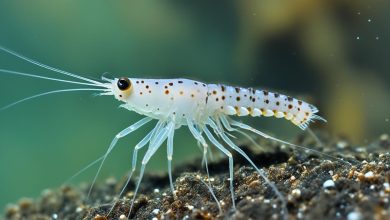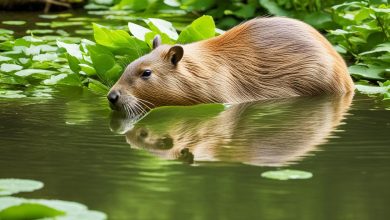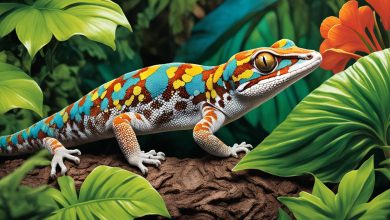In the heart of Africa’s diverse landscapes, a distinct predator thrives – the aardwolf. Known also as the “earth-wolf,” “mane-jackal,” “termite-eating hyena,” and “civet hyena,” this insectivorous creature is the smallest in its family. It specializes in eating termites, consuming up to 300,000 per night with its long, sticky tongue.
The aardwolf’s intriguing adaptations and behaviors highlight its importance in Africa’s wildlife. As an insectivorous mammal and burrower, it’s essential for the ecosystem’s balance. Its nocturnal nature and membership in the mongoose family add to its mystique.
Next, we’ll explore the aardwolf’s world, covering its physical traits, where it lives, what it eats, how it behaves, and its conservation status. Let’s delve into the secrets of this unique African predator and see why it deserves our admiration and protection.
What is an Aardwolf?
Taxonomic Classification and Etymology
The aardwolf (Proteles cristatus) stands out within the Hyaenidae family, once classified in its own family, Protelidae. Its name, “Proteles,” comes from Greek, meaning “complete in front,” highlighting its unique five-toed front feet. The specific name “cristatus” means “provided with a comb,” a nod to its prominent mane.
Physical Description and Characteristics
The aardwolf looks like a smaller, thinner striped hyena. It boasts a slender muzzle, a coat with black stripes, and a long, dark mane down its back. This mane can be raised when threatened. It reaches up to 20 inches in height and is 22 to 31 inches long, making it the smallest of the four hyena types.
It emerged as a distinct species about 15 million years ago, diverging from other hyenas genetically. Fossils of an extinct hyena, Gansuyaena megalotis, found in China, date back 12 to 15 million years. These fossils show a similar diet to aardwolves, indicating their specialized eating habits have ancient roots.
| Characteristic | Measurement |
|---|---|
| Length | 22 to 31 inches (55 to 80 cm) |
| Height | Up to 20 inches (50 cm) |
| Weight | 24 to 35 pounds (11 to 16 kg) |
Distribution and Habitat of Aardwolves
Aardwolves, unique African predators, thrive in the open, dry plains and bushlands of Eastern and Southern Africa. They inhabit two distinct populations. One spans Southern Africa, from central Angola and Mozambique to South Africa. The other stretches from central Tanzania to southern Egypt in East and Northeast Africa.
Their distribution is closely tied to the availability of their main food source: termites from the Hodotermitidae family. These specialized feeders depend heavily on these termites. Therefore, they are found where these termites are most abundant.
| Region | Habitat | Aardwolf Density |
|---|---|---|
| Southern Africa | Open, dry plains and bushland | 1 aardwolf per square kilometer |
| East Africa | Open, dry plains and bushland | 2.6 aardwolves per square mile (1 per square kilometer) |
Aardwolves are well-suited to their environment. Their slender build and long legs enable them to move efficiently across the open terrain. They use dens, often taken over from springhares, as their front legs are not strong enough for digging new burrows.

The northern and southern subspecies of aardwolves are separated by over 930 miles (1,500 kilometers) in Africa. Despite this distance, they share similar habitat preferences and adaptations to their environment.
Aardwolf Diet and Feeding Habits
The aardwolf is a highly specialized termite eater, focusing almost entirely on termites, especially those of the Trinervitermes genus. It can devour up to 300,000 termites each night, using its long, sticky tongue to gather them from the ground. Its teeth, except for sharp canines, have shrunk to pegs, reflecting its lack of need to chew meat.
Termite Specialization
The aardwolf is a true termite specialist, with its anatomy and behavior tailored for this unique diet. It uses its sharp sense of smell to find termite mounds and colonies, which are the mainstay of its diet. By eating termites, the aardwolf helps maintain the balance of these vital ecosystem engineers.
Foraging Techniques
- The aardwolf uses its acute hearing to detect termites in the ground, allowing it to efficiently target its prey.
- With its broad tongue, the aardwolf can gather large quantities of termites without destroying the mound, ensuring a continuous food supply.
- This unique foraging strategy ensures the aardwolf can access a reliable and sustainable source of food, even in areas where termite numbers may fluctuate.
The aardwolf’s specialized diet and foraging techniques highlight its remarkable adaptations. These allow it to excel as a highly efficient termite specialist in the grasslands and savannas of Eastern and Southern Africa.
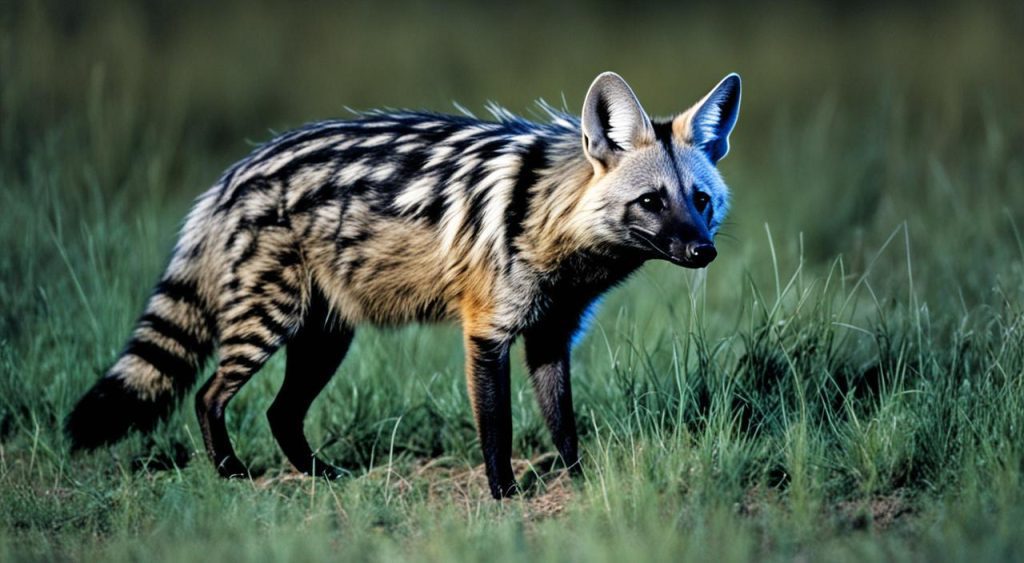
Aardwolf Behavior and Ecology
The aardwolf is a shy, nocturnal animal, spending most of its time alone. These elusive predators come out at night to hunt, using their sharp senses to move through the dark. They are not built for speed or fighting, so they’ve developed unique ways to survive.
Nocturnal and Solitary Lifestyle
Aardwolves are mainly solitary, only coming together in pairs to mate. They hide in old burrows or dens during the day, venturing out at dusk to hunt. Their nocturnal and solitary ways help them avoid bigger predators and save energy. If threatened, they might backtrack or stand tall to look bigger, rather than fight.
Research has found a positive interaction between aardwolves and aardvarks in the Serengeti National Park. This could mean they have a commensal relationship, where aardwolves get more food thanks to aardvarks, especially when food is scarce.
| Characteristic | Aardwolf | Aardvark |
|---|---|---|
| Diet | Grass-harvesting termites | Diverse diet of termites and ants |
| Activity Pattern | Largely nocturnal | Largely nocturnal |
| Spatial Overlap | Increased with slope and large carnivore activity | Increased with slope and large carnivore activity |
The way aardwolves and aardvarks live together and overlap in space can be affected by things like slope and big carnivores. This shows how complex the relationships are between different species in the ecosystem.
Reproduction and Mating Patterns
Aardwolves display intriguing reproductive behaviors, unique among solitary animals. They only unite for mating and raising their young. During estrus, or heat, once a year, they form monogamous pairs.
The gestation period is about 90 days, resulting in litters of one to four aardwolf cubs. These cubs are born with their eyes closed, fully dependent on their mother’s milk for the first four months.
- Aardwolves are monogamous, with males and females forming pairs during the mating season.
- Gestation lasts approximately 90 days, and females give birth to litters of 1-4 aardwolf cubs.
- Newborn aardwolf cubs are born with their eyes closed and rely on their mother’s milk for the first four months.
- At around one year of age, both male and female aardwolves leave their mother’s territory and establish their own.
As the aardwolf cubs mature, they become more independent. By about one year old, both males and females depart their mother’s territory to start their own. This reproductive strategy is crucial for their survival in harsh environments.
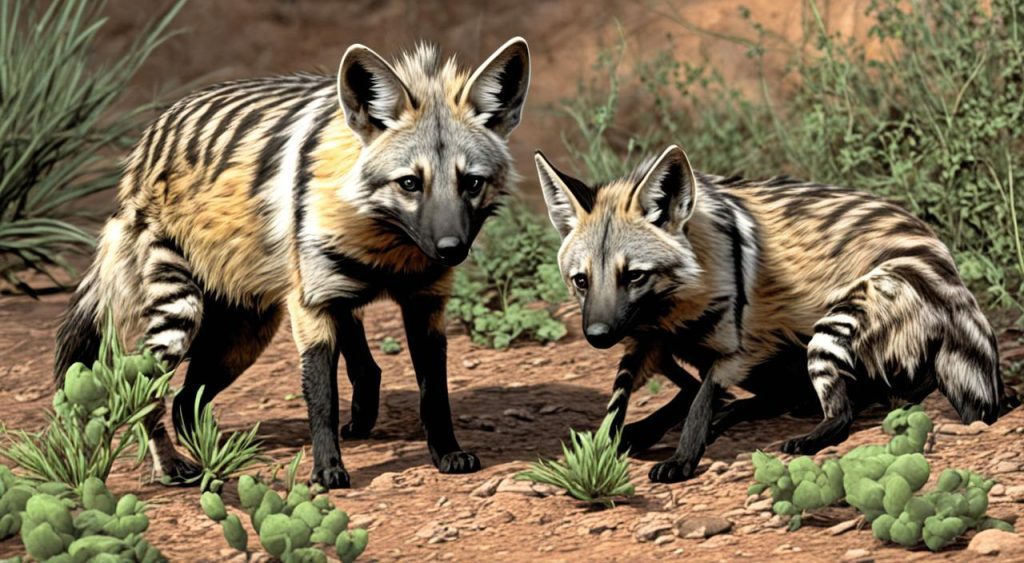
“Aardwolves are among the four living species in the hyena family, exhibiting a fascinating blend of monogamous and polygamous behaviors.”
Aardwolf Territorial Behavior
Aardwolves are fiercely territorial, with a pair and their young occupying a territory of 1 to 4 square kilometers. Both males and females mark their territory using scent glands, leaving black streaks on rocks and grass. They mark their territory up to 200 times per night, especially along its edges.
Marking Territories
Aardwolves possess anal glands that secrete a musky, black fluid. They use this secretion to mark their territory, leaving streaks on objects like rocks and grass. This scent-marking behavior communicates their presence and deters neighboring aardwolves from encroaching on their territory.
Den Usage and Rotation
Aardwolves use a system of dens, rotating through up to 10 different ones every six months. This strategy prevents depleting the local termite populations by not staying in one den too long. Their ability to adapt their denning habits is crucial for their survival in their ecological niche.
| Aardwolf Territorial Behavior Characteristics | Details |
|---|---|
| Territory Size | 1-4 square kilometers |
| Scent Marking Frequency | Up to 200 times per night |
| Number of Dens Utilized | Up to 10 dens rotated every 6 months |
| Denning Adaptations | Prevents local termite population depletion |

“Aardwolves are masters of their domain, meticulously marking their territories and rotating through a network of dens to ensure a sustainable supply of their primary food source – termites.”
Aardwolf Conservation Status
The aardwolf, a distinct predator in Africa, boasts a stable population due to its specialized diet and unique adaptations. The International Union for the Conservation of Nature (IUCN) has classified it as a Least Concern species. This classification reflects the aardwolf’s thriving presence in numerous national parks and reserves across the continent.
Yet, the aardwolf faces significant challenges. Habitat loss, primarily from human development, threatens its survival. The destruction of termite mounds, crucial for their sustenance, is a major concern. Additionally, predation by black-backed jackals and domestic dogs poses threats, albeit not as severe for the overall population.
Fortunately, aardwolf protected areas are established throughout its range. These efforts are vital for the species’ long-term survival. They enable the aardwolf to maintain its essential role in the ecosystem.
| Aardwolf Population Trends | IUCN Status | Threats | Protected Areas |
|---|---|---|---|
| Stable | Least Concern | Habitat loss, occasional predation | National parks and reserves throughout Africa |
“The aardwolf’s specialized diet and adaptations have allowed it to maintain stable populations across its range, but ongoing habitat loss remains a concern for its long-term survival.”
Unique Adaptations of the Aardwolf
The aardwolf, a unique member of the hyena family, has evolved remarkable physical adaptations for its specialized termite-eating lifestyle. These adaptations are essential for its survival and success in its natural habitat.
Physical Adaptations for Termite Consumption
Its long, sticky tongue is a standout feature. This tongue is tough, enabling the aardwolf to lap up thousands of termites nightly. Unlike other hyenas, its teeth have reduced to pegs, except for sharp canines. It consumes large amounts of sand to aid digestion of its soft, insect diet.
The aardwolf weighs between 7.7 to 13.5 kg and measures about 90 cm in length. These dimensions facilitate its movement and access to termite mounds. Its nocturnal and solitary nature allows it to forage undisturbed at night.
These adaptations make the aardwolf a successful termite-eating predator in African ecosystems.
Aardwolves in African Culture and Mythology
The aardwolf, a unique and intriguing mammal, has a significant place in African cultural and mythological traditions. Known as the “maanhaar-jackal” or “mane-jackal” in Afrikaans, it has captured many imaginations with its distinctive look and mysterious nature.
In some African regions, the aardwolf is linked to supernatural or ominous beliefs, seen as a harbinger of bad luck. Yet, this contrasts with its role in controlling termite populations without harming their mounds. This shows the aardwolf’s generally harmless and beneficial nature in its ecosystem.
Despite these beliefs, the aardwolf is widely respected and valued in many African communities. Its unique diet and foraging skills make it a key part of the continent’s natural heritage. The aardwolf’s ability to survive in harsh conditions symbolizes the resilience and adaptability of African wildlife.
Through stories, folktales, and art, the aardwolf has become part of African cultural identity. Its mysterious night-time presence has inspired tales that highlight the deep bond between Africans and their natural environment.
| Aardwolf Cultural Significance | Aardwolf Mythology | Aardwolf in African Folklore |
|---|---|---|
| Seen as a symbol of protection in some regions Associated with ominous or supernatural beliefs in others Respected for its unique adaptations and role in the ecosystem Incorporated into the artistic and oral traditions of African cultures | Depicted in stories and legends as a mysterious, elusive creature Folklore tales often reflect the aardwolf’s nocturnal and solitary nature Beliefs about the aardwolf’s connection to the spiritual world or supernatural forces Aardwolf symbolism in cultural ceremonies and rituals | Aardwolf featured in traditional African folktales and oral histories Stories emphasize the aardwolf’s unique physical characteristics and behaviors Aardwolf’s role in maintaining the balance of ecosystems reflected in folklore Aardwolf seen as a protector or beneficent creature in some African communities |
The aardwolf’s lasting presence in African culture and mythology highlights its cultural importance. It has garnered deep respect and fascination among Africans. As a symbol of Africa’s rich natural heritage, the aardwolf continues to inspire and captivate those interested in the continent’s diverse wildlife.
Fascinating Aardwolf Facts
The aardwolf, a member of the hyena family, stands out as a unique and captivating creature. Let’s explore some fascinating facts about this remarkable animal:
- The aardwolf is the smallest member of the hyena family, typically weighing between 17 and 30 pounds.
- Aardwolves have an average lifespan of 7 years in the wild.
- An individual aardwolf can consume up to 300,000 termites in a single night.
- Aardwolves have specialized adaptations, such as a tough tongue and reduced teeth, that allow them to efficiently consume their termite-based diet.
- Despite their hyena-like appearance, aardwolves are not known to scavenge or kill larger prey, making them a unique and specialized predator within the African ecosystem.
Aardwolves are more closely related to felines than other animals in the hyena family. They are also known for their shy and secretive nature, often struggling to thrive in captivity.
| Aardwolf Fact | Statistic |
|---|---|
| Termites Consumed per Night | up to 300,000 |
| Termite Mounds Needed to Sustain a Pair | 3,000 |
| Ability to Increase Size When Threatened | 70% |
| Percentage of Dung Containing Sand | 50% |
| Aardwolf Lifespan in the Wild | 7-10 years |
These fascinating aardwolf facts reveal the unique adaptations and behaviors of this remarkable aardwolf species. They highlight its critical role in the African ecosystem. From its impressive termite consumption to its shy and elusive nature, the aardwolf is truly a remarkable predator worth learning more about.
The Role of Aardwolves in the Ecosystem
Aardwolves are crucial to African ecosystems, controlling termite populations without harming their mounds. They consume vast amounts of termites nightly, thus regulating their numbers. This prevents overpopulation, which could damage vegetation and crops. Their feeding habits allow termite colonies to flourish, ensuring they perform vital ecological roles like soil aeration and organic matter breakdown.
As specialized predators, aardwolves enhance biodiversity and health in African savannas and grasslands. They maintain ecosystem balance by controlling termites without landscape disruption. Their role showcases the complex relationships within nature, underscoring the importance of their conservation for preserving ecosystem diversity and resilience.
Aardwolves, as termite regulators, highlight the significance of specialized predators in ecosystems. Their gentle nature and non-destructive feeding habits make them a vital part of African wildlife. This underscores the need for ongoing research and conservation efforts to protect these remarkable creatures and their essential services.
FAQ
What is an aardwolf?
The aardwolf is an insectivorous hyaenid species native to East and Southern Africa. It is the smallest extant member of the Hyaenidae family. Known for its specialized termite-eating lifestyle, it stands out in the animal kingdom.
Where can aardwolves be found?
Aardwolves inhabit the open, dry plains and bushland of Eastern and Southern Africa. They are found in two distinct populations: one in Southern Africa and another in East and Northeast Africa.
What do aardwolves eat?
Aardwolves are highly specialized termite eaters. Their diet consists almost exclusively of termites, particularly those of the Trinervitermes genus. They can consume up to 300,000 termites in a single night using their long, sticky tongues.
How do aardwolves behave?
Aardwolves are shy, nocturnal animals that spend the day resting in abandoned burrows. They emerge at night to forage. They are primarily solitary, though they form monogamous pairs during the mating season.
How do aardwolves reproduce?
Aardwolves are solitary animals that only come together to mate and rear their young. Females give birth to litters of one to four cubs. These cubs are dependent on their mother’s milk for the first four months of their lives.
What is the conservation status of aardwolves?
The International Union for the Conservation of Nature (IUCN) has classified the aardwolf as a species of Least Concern. This classification reflects thriving populations throughout many national parks and reserves in Africa. However, habitat loss due to human development can be a threat to the species.
What unique adaptations do aardwolves have?
Aardwolves have evolved unique physical adaptations for their specialized termite-eating lifestyle. These include a long, sticky tongue and reduced teeth that are no longer needed for chewing meat.
How do aardwolves fit into the African ecosystem?
Aardwolves play a vital role in the delicate balance of African ecosystems. They control termite populations without destroying the termite mounds. Their non-destructive feeding habits ensure that termite colonies can continue to thrive and maintain their important ecological functions.

